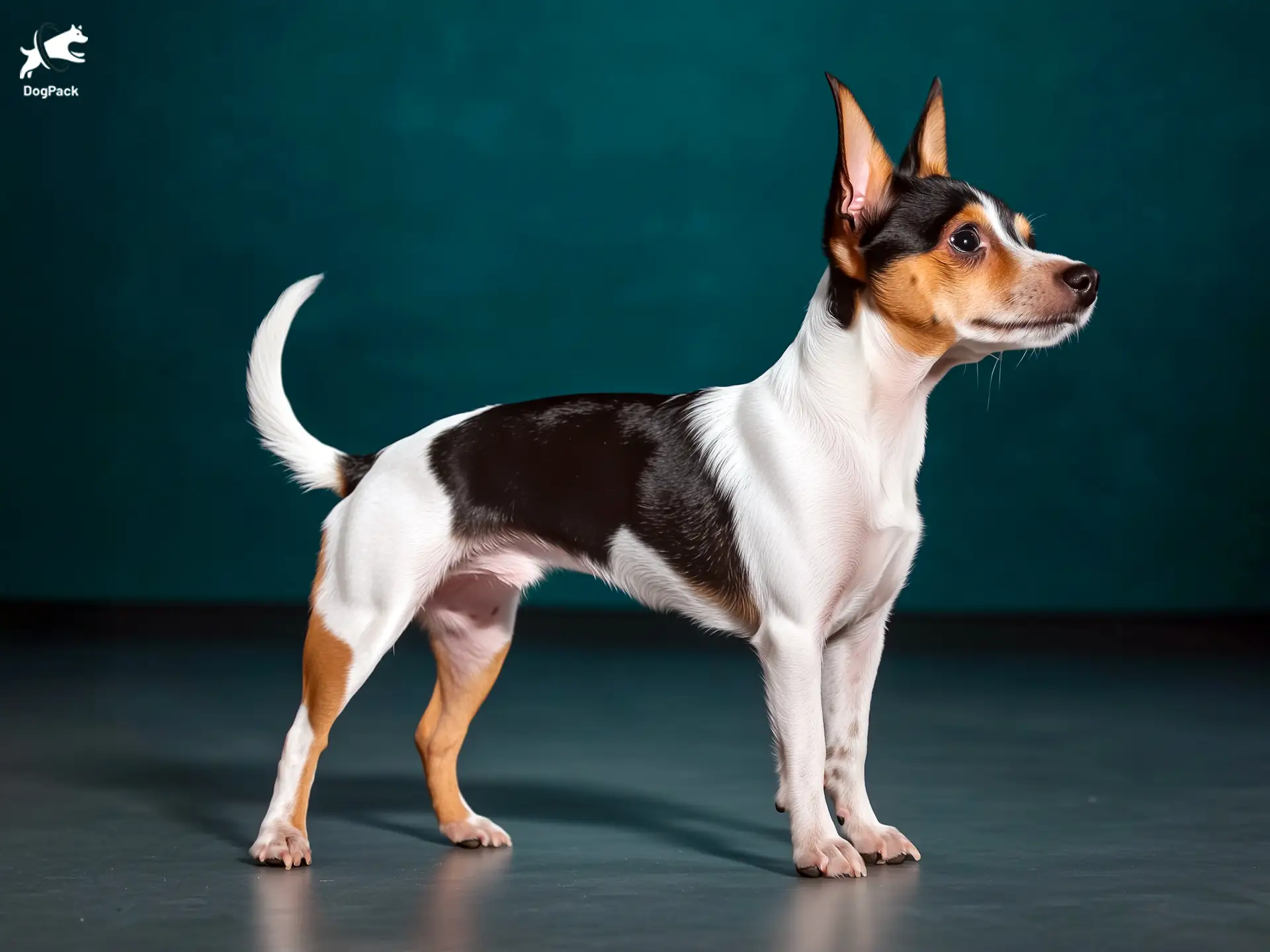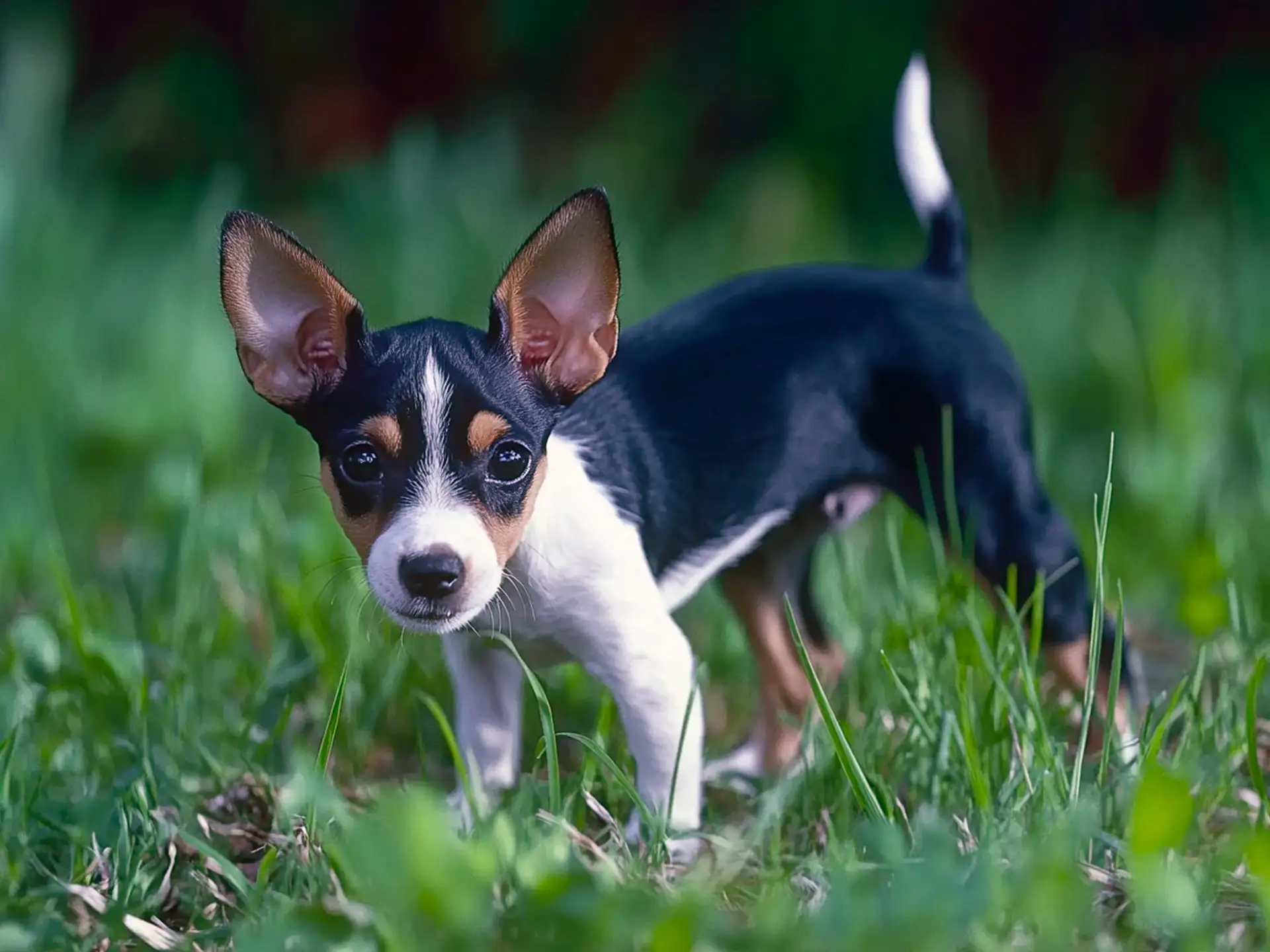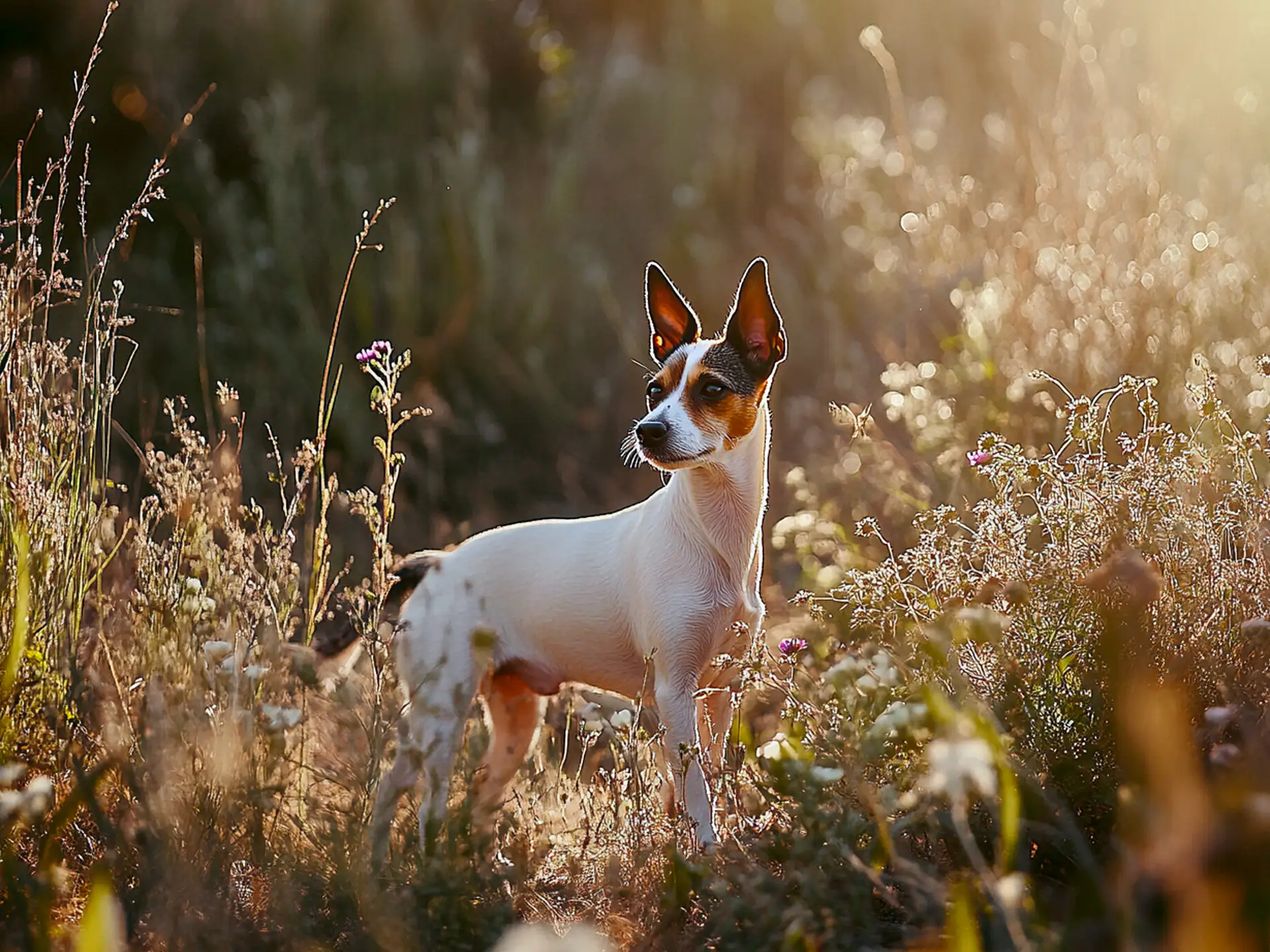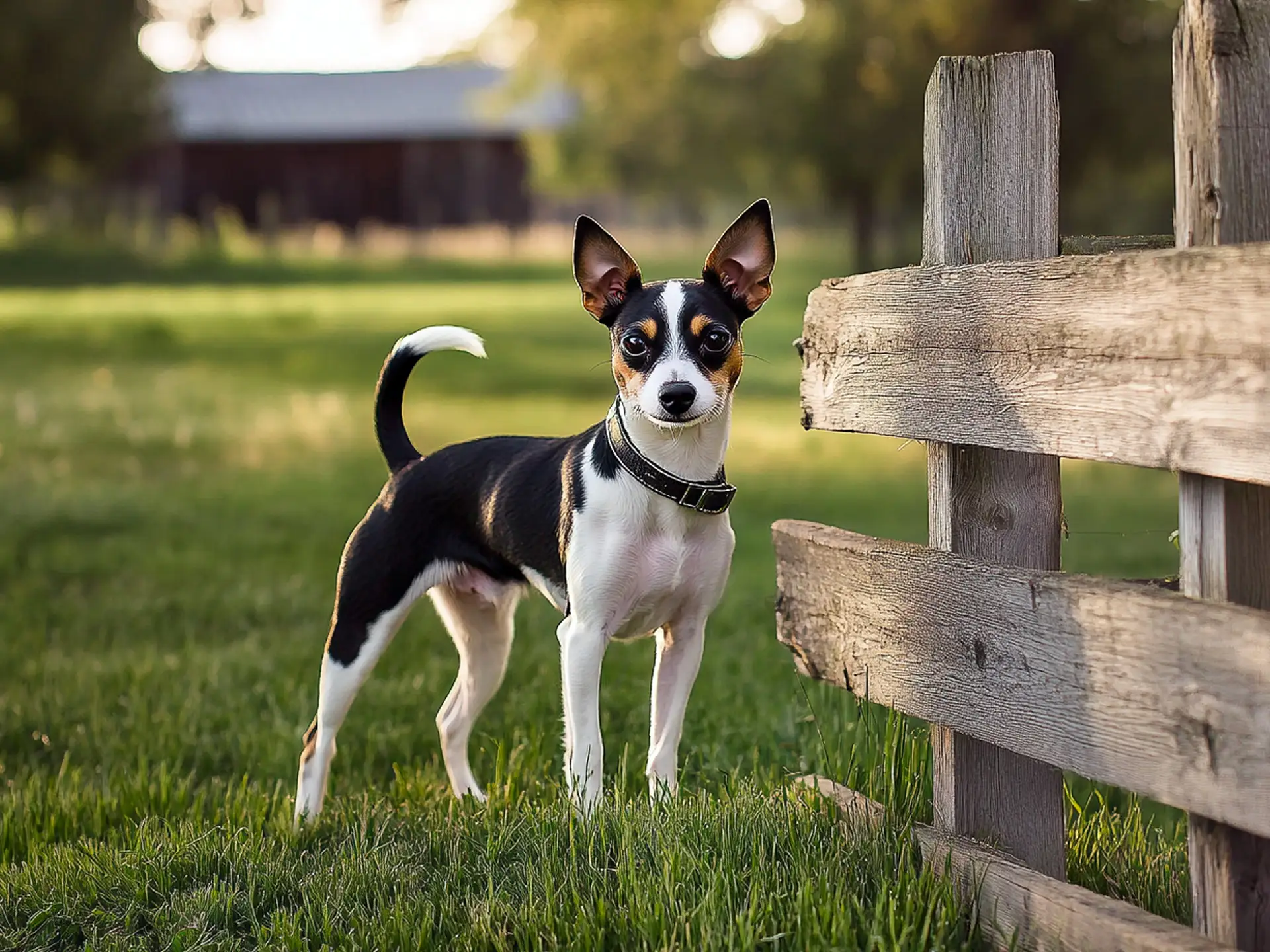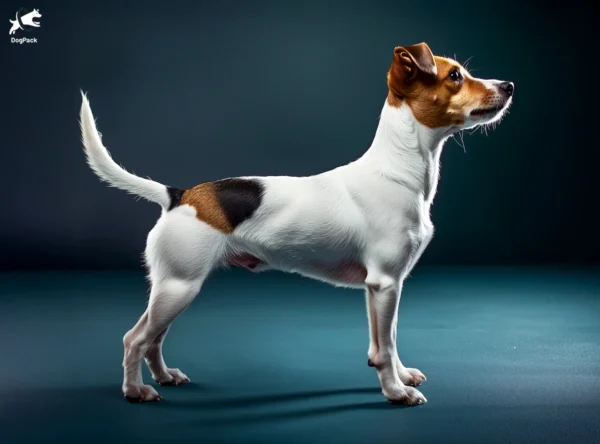Rat Terrier Dog Breed Info & Overview
Rat Terriers are a spirited, pint-sized breed known for their unwavering loyalty and fearless demeanor. Historically bred for rodent control on farms, these clever companions quickly won hearts with their keen intelligence and spunky charm. Whether they’re chasing a squeaky toy or snuggling on the couch, they bring a burst of energy and fun to any household.
Characteristics
Pictures
Breed History
Stories claim that these spirited canines originated in the early 1900s, gaining fame on American farms for their tenacity in controlling rodent populations. Their diminutive stature and lively nature made them indispensable for pest control, quickly earning them popularity across rural communities. As their reputation grew, folks discovered how well they adapted to both farmland and family life.
Despite their small size, these dogs caught the attention of notable figures, including President Theodore Roosevelt, who allegedly coined the name Rat Terrier for these fearless hunters. Over time, selective breeding refined their agility and stamina, shaping a breed that excelled at chasing vermin and providing companionship. The resulting lineage combined determination, intelligence, and an eagerness to please.
Today, historians debate the exact mix of ancestors—possible influences include Fox Terriers, Bull Terriers, and even Whippets. Nevertheless, the outcome is a distinct little powerhouse that symbolizes America’s love for scrappy, hard-working dogs. While many appreciate them for their pest-chasing skills, modern fans celebrate their affectionate side, making them treasured companions in countless households.
Temperament, Personality
Bouncy and bright, these terriers can keep you on your toes with their playful antics. They thrive on interaction, eagerly seeking games that challenge their minds. While they’re often full of energy, their eagerness to bond with their human companions makes them surprisingly affectionate. If you’re looking for a pup that loves to tag along everywhere, you’ll find it here.
Because they form strong attachments to their families, they might show a hint of protective behavior, especially around strangers. Early socialization helps them distinguish friend from foe, ensuring a well-rounded demeanor. Their confidence can sometimes manifest as sass, but with consistent guidance, they adapt quickly to household norms, offering an engaging mix of spunk and sweetness.
Rat Terrier owners often describe these pups as miniature comedians, eager to keep everyone smiling. While they generally do well with older children, supervising playtime with younger kids is wise due to the breed’s spirited nature. Introductions to other pets should be gradual, but once comfortable, they’re quite content sharing a home with fellow furry friends.
Physical Characteristics
Although petite, these canines are sturdily built with a sleek, muscular frame that belies their compact stature. Their head typically sports a wedge-like shape and upright ears that stand at attention, giving them an alert, inquisitive expression. Coats are short and glossy, often featuring a combination of white, black, tan, or chocolate, highlighting their lively and bold presence.
The tail can vary in length, with some naturally short and others docked to a shorter stub. While their legs might appear delicate at first glance, they carry surprising power, allowing swift movement during play or when chasing after a tempting squeaky toy. Their eyes, round and expressive, easily convey curiosity, excitement, and sometimes a bit of mischievous intent.
Rat Terrier dogs typically range between 10 and 18 inches tall, standing proudly without appearing fragile. Their weight usually hovers around 10 to 25 pounds, ensuring portability yet sturdiness. Despite their smaller stature, they exude a dynamic aura, easily drawing admiration from those who appreciate a confident demeanor wrapped in a conveniently sized package.
Health Issues
While generally robust, these dogs can be prone to certain inherited conditions. Patellar luxation, a kneecap disorder, may cause occasional lameness or discomfort, especially if not addressed early. Another concern is hip dysplasia, though less common in this smaller breed compared to larger dogs. Regular vet checkups and early detection can help maintain mobility and overall well-being.
Allergies, whether environmental or food-related, can pop up in the form of itching or digestive issues. Dental care is also crucial, as small breeds can experience faster plaque buildup. Scheduling routine teeth cleaning and providing appropriate chew toys can go a long way in preventing tartar accumulation, keeping those jaws ready for enthusiastic play or treat-time munchies.
Rat Terrier enthusiasts suggest paying close attention to your dog’s weight, as even a few extra pounds can strain joints. Keeping them active and feeding a balanced diet is essential. Regular veterinary screenings, including heart checks, eye exams, and blood panels, offer the best chance at catching any emerging issues early and ensuring a lifetime of vibrant, wagging-tailed adventures.
Grooming Needs
Their short, dense coat requires minimal fuss. A quick brush once or twice a week is typically enough to keep shedding under control and maintain a healthy shine. Many owners find that a rubber grooming mitt helps remove loose hairs while offering a gentle massage that dogs often love, turning grooming into a bonding session rather than a chore.
Bathing requirements are modest, usually once every month or two, depending on how much outdoor exploration they enjoy. Over-bathing can strip essential oils, so it’s best to keep it occasional unless your pup decides to roll in something particularly pungent. Use a gentle, dog-specific shampoo to prevent irritation and keep skin and coat in top-notch condition.
Rat Terrier guardians appreciate that upkeep is straightforward: trim nails regularly to avoid discomfort, clean ears to prevent buildup, and brush teeth for optimal dental health. Because they’re not heavy shedders, daily vacuuming isn’t a must. This easy-care routine makes them appealing for busy households or anyone seeking a low-maintenance, yet spunky, canine companion.
Exercise Requirements
Despite their small size, these pups have abundant energy and thrive when given the chance to burn it off. Daily walks of at least 30 minutes, coupled with interactive play sessions, can keep them physically satisfied and mentally sharp. Agility courses and puzzle toys are excellent ways to challenge their minds, preventing boredom-induced mischief.
They relish having a backyard to zoom around in, though it’s not an absolute necessity. Apartments can work if owners commit to consistent outings and stimulating indoor games. A few rounds of fetch in a hallway, or a brisk walk around the block, can help meet their activity quota. Physical outlets also reduce the likelihood of excessive barking.
Rat Terrier individuals excel when they have varied activities that engage both body and mind. Fetch, hide-and-seek, or even joining canine sports like flyball can keep them on their toes. Regular exercise not only maintains a healthy weight but also channels their innate drive to chase and hunt, leaving them content and ready to snuggle up afterward.
Training Tips
Positive reinforcement works wonders with these bright canines, who respond eagerly to praise, treats, and enthusiastic attention. Using short, engaging sessions helps them stay focused, as they can be easily distracted by intriguing scents or passing squirrels. Patience and consistency are key; rather than repeating commands endlessly, switch tasks to keep them motivated and prevent boredom.
Because they have a history of independent problem-solving, it’s essential to establish clear rules from the beginning. Provide structure through crate training and a set routine for meals and exercise. This predictability fosters good habits, while also reassuring them about what’s expected. Incorporating fun games—like nose work or treat-dispensing puzzles—taps into their inquisitive terrier nature.
Rat Terrier enthusiasts recommend socializing puppies from a young age, introducing them to various people, sounds, and environments. This early exposure reduces fearfulness and the likelihood of territorial or timid behaviors. As they mature, continued mental stimulation—through advanced obedience classes or trick training—further harnesses their intelligence, making them well-adjusted companions who delight in pleasing their humans.
Nutrition, Diet
These agile pups often benefit from a high-quality, protein-rich diet formulated for small, active breeds. Look for dog foods containing lean meats like chicken or turkey as the primary ingredient, ensuring adequate amino acids for muscle maintenance. Some Rat Terrier owners choose grain-free options, but it’s wise to consult with your vet for guidance on what best suits individual needs.
Portion control is vital. An adult typically consumes around half a cup to a full cup of dry food daily, split into two meals. Adjust the exact amount based on factors like age, activity level, and metabolism. If your terrier is constantly on the go, they may require slightly more, but monitor their waistline to prevent overfeeding.
Include occasional fresh foods—like small servings of cooked vegetables or plain boiled chicken—to keep mealtime interesting. Steer clear of fatty or heavily processed scraps that could upset their stomach. Regular weigh-ins help you stay ahead of unwanted pounds. By tailoring a diet to your pet’s energy needs, you’ll support a spry, lively companion eager for the next adventure.
Adoption, Breeders
For those considering adding a terrier to the family, start by exploring reputable rescues or shelters. Countless dogs are in need of loving homes, and you might find a perfect match waiting for you. Alternatively, local rat terrier rescue organizations specialize in this breed, offering guidance on temperament and care. Adopting can be both rewarding and cost-effective.
If you prefer working with a breeder, ensure they follow ethical practices, including health testing for common issues. A transparent breeder will welcome questions, allow visits, and provide ample background on their litters. By investing in a well-bred puppy, you set the stage for a healthier life. Always request medical records, references, and a clear contract outlining responsibilities.
Rat Terrier Club of America is a great resource for breeder referrals and detailed information. Reputable clubs often maintain strict standards, helping preserve the breed’s best qualities. Whichever route you choose, taking time to research and ask the right questions ensures your new companion will be a cherished family member for years to come.
Family Pet?
Many families are pleasantly surprised by how well these terriers adapt to bustling households, joining in on games and activities with boundless enthusiasm. Their energy makes them entertaining companions, especially for families who love playing outdoors. At the same time, they’re small enough to cuddle up on the couch without taking up too much real estate.
They’re typically patient with respectful children, though supervision is always a good idea. Because of their strong prey drive, watch interactions with small pets like hamsters or gerbils. With proper introductions and training, they often learn to coexist peacefully, but it’s wise to set rules early. When they feel included and loved, they respond with unwavering loyalty.
Rat Terrier devotees frequently mention that these dogs thrive in family settings where attention is plentiful. They relish being at the center of action, forming tight bonds with their favorite humans. If your household can provide daily playtime, gentle guidance, and a healthy dose of affection, you’ll likely find this compact companion a fantastic fit for a lively family dynamic.
Right For You?
Prospective owners should consider whether they have the time and energy to engage a spirited terrier. These dogs excel with dedicated individuals who enjoy short training sessions, puzzle toys, and interactive fun. If you’re looking for a couch potato to lounge for hours on end, you might be disappointed, as their playful spark often demands at least moderate activity.
Living arrangements also matter. While they can adapt to apartment life, frequent walks and mental stimulation are non-negotiable. A safe, fenced yard can be ideal for zoomies and exploration, though consistent supervision prevents any escape attempts. Taking noise levels into account is wise—especially in shared living spaces—because terriers can be vocal when excited or alarmed.
Owning a Rat Terrier can be especially rewarding if you value a loyal, intelligent companion with a bit of spunk. They thrive in homes where boundaries are clearly set and daily exercise is a given. Ultimately, if you’re ready to invest time in training and can handle a dash of high-energy charm, this breed’s loyalty and amusing antics can be a delight.
Conclusion
Deciding whether to welcome a terrier into your life depends on your readiness for an active, clever, and loving sidekick. These small but mighty dogs can adapt to various living situations, so long as their exercise and mental stimulation needs are met. With proper socialization and consistent training, they blossom into delightful companions, capturing hearts with their comedic charm. If you relish a dog that’s ready for both a brisk game of fetch and a cozy evening on the couch, you may have found your match. A Rat Terrier is likely to repay your care and attention with unwavering devotion and a dash of mischief, making everyday life just a little more fun.
FAQs
-
What makes the Rat Terrier different from other terriers?
The Rat Terrier stands out due to its versatility as a hunting, farm, and companion dog. Unlike most terriers bred for a single purpose, it excels in ratting, tracking, agility, and obedience sports. They also have a distinctively sleek body, longer legs, and a more social temperament than feistier terriers.
-
Can a Rat Terrier live in an apartment?
Yes, but only if they get enough exercise. Despite their small size, Rat Terriers are high-energy dogs that need at least an hour of daily activity. Without proper mental and physical stimulation, they may develop destructive behaviors like digging, chewing, or excessive barking.
-
Do Rat Terriers make good off-leash dogs?
Rat Terriers have a strong prey drive, which can make off-leash training challenging. While they can be trained for recall, they are naturally inclined to chase after small animals. Secure, fenced areas are recommended for safe off-leash play.
-
Are Rat Terriers good watchdogs?
Yes! Rat Terriers are naturally alert and will bark at unfamiliar noises or strangers. They are not aggressive, but their keen senses and strong territorial instincts make them excellent watchdogs for alerting owners to potential threats.
-
Do Rat Terriers dig a lot?
Yes, digging is instinctive for Rat Terriers due to their history as vermin hunters. Providing designated digging areas, mental stimulation, and sufficient playtime can help redirect this natural behavior and prevent excessive digging in yards or gardens.
Breed Ratings
Incredibly sharp, they excel at picking up commands and enjoy mental challenges to keep boredom at bay.
Usually eager for games and entertainment, though they also value a little downtime with their human companions.
Bursting with vigor, they need daily exercise and mental stimulation to remain happy and well-behaved.
Short coat sheds moderately; weekly brushing helps keep stray hairs and dander under control.
Strongly inclined to chase small animals, a reflection of their roots as skilled vermin hunters.
Low-maintenance coat requires minimal brushing, and bathing is only necessary when they get truly dirty.
Quick learners who respond well to positive reinforcement but can be stubborn without consistent routines.
Can manage brief periods solo, yet they prefer human company and can become vocal when lonely.
Likely to alert you to new sights or sounds, but proper training helps moderate excessive noise.
Rarely drools, making them a tidy companion around the house even in warm weather or when excited.
Generally sociable if well-socialized early, but they may show some bossiness with unfamiliar canines.
Usually robust, though prone to minor joint and dental issues; regular checkups keep them in top shape.

